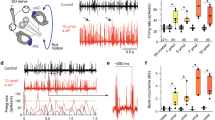Abstract
The effects of intraventricular injection of serotonin (5-HT) and its agonists and antagonists on the amplitude of the vestibulo-ocular reflex were studied in chronic implanted rats. 5-HT (10−5 M) triggers an increase of the amplitude of the reflex which lasts 30 min. Similar results are obtained when N,N-dimethyl-5-methoxytryptamine (10−3 M) is introduced into the ventricular cannula. The increasing effects observed both with 5-HT and N,N-dimethyl-5-methyoxy-tryptamine are abolished by methiothepin, a potent antagonist of 5-HT receptors. Injection of indirect agonists like pargyline, a monoamine oxidase inhibitor, or fluoxetine, a potent inhibibitor of 5-HT reuptake, is followed by an increase of the amplitude of the vestibulo-ocular reflex. These results indicate that 5-HT can modulate the activity of the vestibulo-ocular pathway and muscular tone of extraocular muscles. Location and involvement of various modulating 5-HT sites are discussed.
Similar content being viewed by others
References
Andèn NE, Jukes MGM, Lundberg A (1964) Spinal reflexes and monoamine liberation. Nature 202:1222–1223
Anderson EG, Shibuya T (1966) The effects of 5-hydroxytryptamine and L-tryptophan on spinal synaptic activity. J Pharmacol Exp Ther 153:352–360
Banna NR, Anderson EG (1968) The effects of 5-hydroxytryptamine antagonists on spinal neuronal activity. J Pharmacol Exp Ther 162:319–325
Barasi S, Roberts MHT (1974) The modification of lumbar motoneurone excitability by stimulation of a putative 5-hydroxytryptamine pathway. Br J Pharmacol 52:339–348
Brodie BB, Shore PA (1957) A comcept for a role of serotonin and norepinephrine as chemical mediators in the brain. Ann NY Acad Sci 66:631–642
Carp JS, Rymer WZ (1986) Enhancement by serotonin of tonic vibration and stretch reflexes in the decerebrate cat. Exp Brain Res 62:111–122
Dahiström A, Fuxe K (1964) Evidence for the existence of monoamine-containing neurons in the central nervous system. I. Demonstration of monoamines in the cell bodies of brain stem neurons. Acta Physiol Scand 62: Suppl 232:1–55
Dahlström A, Fuxe K (1965) Evidence for the existence of monoamine neurons in the central nervous system. II. Experimentally induced changes in the intraneuronal amine levels of bulbospinal neuron systems. IV. Distribution of monoamine nerve terminals in the central nervous system by Fuxe K. Acta Physiol Scand 64 suppl 247:1–85
Dixon D, Atwood HL (1985) Crayfish motor nerve terminal's response to serotonin examined by intracellular microelectrode. J Neurobiol 16:409–424
Enberg I, Flatman JA, Kadzielawa K (1974) The hyperpolarization of motoneurones by electrophoretically applied amines and other agents. Acta Physiol Scand 91:2A-4A
Enberg I, Flatman JA, Kadzielawa K (1976) Lack of specificity of motoneurone responses to microiontophoretically applied phenolic amines. Acta Physiol Scand 96:137–139
Glicksman MA (1980) Localization of motoneurons controlling the extraocular muscles of the rat. Brain Res 188:53–62
Grahame-Smith DG (1974) How important is the synthesis of brain 5-hydroxytryptamine in the physiological control of its central function?. Adv Biochem Psychopharmacol 10:83–91
Green AR, Grahame-Smith DG (1976) Effect of drugs on the processes regulating the functional activity of brain 5-hydroxytryptamine. Nature 260:487–491
Haigler HJ, Aghajanian GK (1977) Serotonin receptors in the brain. Fed Proc 36:2159–2164
Hounsgaard J, Kiehn O (1985) Ca2+-dependent bistability induced by serotonin in spinal motoneurons. Exp Brain Res 57:422–425
Hounsgaard J, Hultborn H, Jespersen B, Kiehn O (1984) Intrinsic membrane properties causing a bistable behaviour of alphamotoneurones. Exp Brain Res 55:391–394
Jacoby JH, Shabshelowitz H, Fernstrom JD, Wurtman RJ (1975) The mechanism by which methiothepin, a putative serotonin receptor antagonist increases brain 5-hydroxyindole levels. J Pharmacol Exp Ther 195:257–264
Jalfre M, Ruch-Monachon MA, Haefely W (1974) Methods for assessing the interaction of agents with 5-hydroxytryptamine neurons and receptors in the brain. Adv Biochem Psychopharmacol 10:121–134
McCall RB, Aghajanian GK (1979) Serotoniergic facilitation of facial motoneuron excitation. Brain Res 169:11–27
Marley E, Vane JR (1967) Tryptamine and spinal cord reflexes in cats. Br J Pharmacol Chemother 31:447–465
Paakkari I (1980) A simple method for the verification of a successful cannulation of the rat cerebral ventricles. Experientia 36:887–889
Palkovits M, Brownstein M, Saavedra JM (1974) Serotonin content of the brain stem nuclei in the rat. Brain Res 80:237–249
Parry O, Roberts MHT (1980) The responses of motoneurones to 5-hydroxytryptamine. Neuropharmacology 1:515–518
Pazos A, Palacios JM (1985) Quantitative autoradiographic mapping of serotonin receptors in the rat brain. I. Serotonin-1. Receptors. Brain Res 346:205–230
Pazos A, Cortes R, Palacios JM (1985) Quantitative autoradiographic mapping of serotonin receptors in the rat brain. II. Serotonin — 2. Receptors. Brain Res 346:231–249
Russell DF, Hartline DK (1982) Slow active potentials and bursting motor patterns in pyloric network of the lobster, Panulirus interruptus. J Neurophysiol 48:914–937
Soghomonian JJ, Descarries L, Lanoir J (1986) Monoamine innervation of the oculomotor nucleus in the rat. A radioautographic study. Neuroscience (in press)
Steinbusch HWM (1981) Distribution of serotonin-immunoreactivity in the central nervous system of the rat. Cell bodies and terminals. Neuroscience 6:557–618
VanderMaelen CP, Aghajanian GK (1980) Intracellular studies showing modulation of facial motoneurone excitability by serotonin. Nature 287:346–347
Whitaker PM, Seeman P (1978) High affinity3H-serotonin binding to caudate: inhibition by hallucinogens and serotoninergic drugs. Psychopharmacology 58:1–5
White SR, Neuman RS (1980) Facilitation of spinal motoneurone excitability by 5-hydroxytryptamine and noradrenaline. Brain Res 188:119–127
Wong DT, Horng JS, Bymaster FP, Hauser KL, Molloy BB (1974) A selective inhibitor of serotonin uptake: Lilly 110140, 3-(p-trifluoromethylphenoxy)-N-methyl-3-phenylpropylamine. Life Sci 15:471–479
Author information
Authors and Affiliations
Rights and permissions
About this article
Cite this article
Ternaux, J.P., Gambarelli, F. Modulation of the vestibulo-ocular reflex by serotonin in the rat. Pflugers Arch. 409, 507–511 (1987). https://doi.org/10.1007/BF00583808
Received:
Accepted:
Issue Date:
DOI: https://doi.org/10.1007/BF00583808



